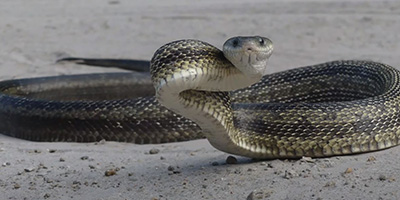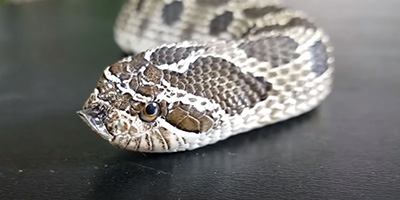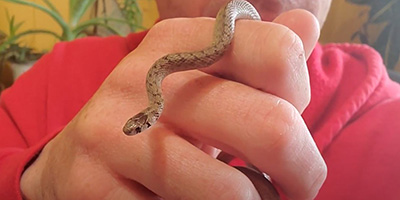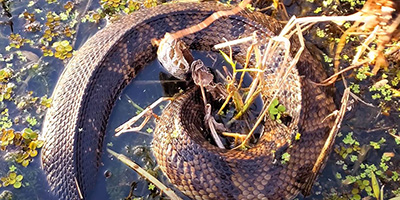
Welcome to houstonsnake.com! I am David, a snake enthusiast living in Houston, TX. Many people don't know that Houston is in fact full of snakes! You just need to know where to find them - they can often be shy and elusive. Some Texas snake species are more common outside of the city limits, in different parts of Harris County TX, but many types of snakes are indeed common in the more urban parts of Houston. This guide is meant to help educate you about the beautiful snakes of Houston, and to help you identify the most common snakes of Houston, as well as the venomous snakes of Houston that you should learn to recognize and avoid. If you want more detail, click here for my complete list of ALL snake species in Houston. Remember the following:
- Most snakes of Houston are harmless and don't want to encounter you
- Venomous snakes exist but are uncommon in Houston, Texas
- Snakes eat rats and mice and are a valuable part of the Texas ecosystem
- Never kill a snake - if you leave a snake alone, it will leave you alone.
Common Snake Species in Houston
 Rat Snakes:
The Texas rat snake is one of the most common snakes found in Texas. These snakes can get to be six feet long and have heavy bodies. They can be identified by their characteristic light background color with square-ish dark spots that are all down their back. The Texas rat snake can be found in many environments, including urban areas, due to their adaptability. They feed primarily on rodents and can climb structures to get to their prey. They are not venomous, however, they can leave a painful bite if provoked.
Rat Snakes:
The Texas rat snake is one of the most common snakes found in Texas. These snakes can get to be six feet long and have heavy bodies. They can be identified by their characteristic light background color with square-ish dark spots that are all down their back. The Texas rat snake can be found in many environments, including urban areas, due to their adaptability. They feed primarily on rodents and can climb structures to get to their prey. They are not venomous, however, they can leave a painful bite if provoked. Hognose Snakes:
The eastern hognose is a very unique looking snake that is common in the Houston, Texas area. They are easily identified by their upturned noses, as their bodies come in a wide variety of colors and patterns. These snakes feed on toads, amphibians, other reptiles, and small mammals. They are non-venomous and will only bite humans if they are provoked or cornered. The eastern hognose can be anywhere from two to three feet in length.
Hognose Snakes:
The eastern hognose is a very unique looking snake that is common in the Houston, Texas area. They are easily identified by their upturned noses, as their bodies come in a wide variety of colors and patterns. These snakes feed on toads, amphibians, other reptiles, and small mammals. They are non-venomous and will only bite humans if they are provoked or cornered. The eastern hognose can be anywhere from two to three feet in length. Brown Snakes :
The marsh brown snake is a very common, and very small snake found in many people’s yards in urban areas. These little guys are usually about a foot long and burrow into yards. The marsh brown snake has a brown background with light-colored stripes along its body. They eat a variety of insects and are commonly found in gardens all around the state of Texas. They are completely harmless to humans, and in many cases, are beneficial to gardens and lawns.
Brown Snakes :
The marsh brown snake is a very common, and very small snake found in many people’s yards in urban areas. These little guys are usually about a foot long and burrow into yards. The marsh brown snake has a brown background with light-colored stripes along its body. They eat a variety of insects and are commonly found in gardens all around the state of Texas. They are completely harmless to humans, and in many cases, are beneficial to gardens and lawns.Venomous Snake Species in Houston
 Copperheads:
The southern copperhead is easily one of the most common venomous snakes around the Houston area. These snakes feature a copper-colored head and copper-colored bands around their body, which is generally a background color of a lighter shade. These snakes are generally around two to three feet long and blend in very well in a variety of habitats. While they prefer to live in areas with high prey populations, these snakes can live in urban areas. The copperhead primarily feeds on rodents, amphibians, and other small critters. While their venom can be deadly, they often do a dry bite, which is where little to no venom is injected.
Copperheads:
The southern copperhead is easily one of the most common venomous snakes around the Houston area. These snakes feature a copper-colored head and copper-colored bands around their body, which is generally a background color of a lighter shade. These snakes are generally around two to three feet long and blend in very well in a variety of habitats. While they prefer to live in areas with high prey populations, these snakes can live in urban areas. The copperhead primarily feeds on rodents, amphibians, and other small critters. While their venom can be deadly, they often do a dry bite, which is where little to no venom is injected.  Rattlesnakes:
The Houston area of Texas is home to four species of rattlesnakes: the western diamondback, the timber rattler, the western massasauga, and the western pigmy. While they live around Houston, it is rare that they would be found deep in the city, though it is always a possibility. The western diamondback is a large snake, capable of being several feet in length. They are easily identified by their dark diamond markings running down their back along with a lighter olive or gray colored background.
The timber rattlesnake is also quickly identifiable by its dark black bands surrounding its lighter-colored body. They also feature a triangular head and heat-sensing pits by their eyes. The western massasauga has a unique pattern of a light background with dark splotches all along their body. A smaller rattlesnake, the massasauga can be two to three feet in length. Finally, the western pigmy rattlesnake features a tan or olive background with black splotches and a copper-colored band running down its back. All of these rattlesnakes are highly venomous and can be deadly if bites are not treated quickly.
Rattlesnakes:
The Houston area of Texas is home to four species of rattlesnakes: the western diamondback, the timber rattler, the western massasauga, and the western pigmy. While they live around Houston, it is rare that they would be found deep in the city, though it is always a possibility. The western diamondback is a large snake, capable of being several feet in length. They are easily identified by their dark diamond markings running down their back along with a lighter olive or gray colored background.
The timber rattlesnake is also quickly identifiable by its dark black bands surrounding its lighter-colored body. They also feature a triangular head and heat-sensing pits by their eyes. The western massasauga has a unique pattern of a light background with dark splotches all along their body. A smaller rattlesnake, the massasauga can be two to three feet in length. Finally, the western pigmy rattlesnake features a tan or olive background with black splotches and a copper-colored band running down its back. All of these rattlesnakes are highly venomous and can be deadly if bites are not treated quickly.
 Cottonmouths:
The western cottonmouth, also known as the water moccasin, is a venomous snake that is well-known for its deadly venom it can inject in people. The cottonmouth generally prefers to live in aquatic environments, though it has been known to inhabit dry areas as well. This snake gets its name from the all-white mouth it has when it is opened to strike at something. These snakes have dark backgrounds and bands, however the bands are rarely seen once they have reached an older age, as the whole snake turns to a darker solid color. These snakes prefer to eat rodents, fish, and amphibians, making them capable of living in a variety of areas.
Cottonmouths:
The western cottonmouth, also known as the water moccasin, is a venomous snake that is well-known for its deadly venom it can inject in people. The cottonmouth generally prefers to live in aquatic environments, though it has been known to inhabit dry areas as well. This snake gets its name from the all-white mouth it has when it is opened to strike at something. These snakes have dark backgrounds and bands, however the bands are rarely seen once they have reached an older age, as the whole snake turns to a darker solid color. These snakes prefer to eat rodents, fish, and amphibians, making them capable of living in a variety of areas.If you're unsure, you can email me a photo of the snake at info@houstonsnake.com and I will email you back with the snake's species. If you found a snake skin, read my Found a Skin? page, and you can email me a photo of the skin, and I'll identify the snake for you. If you need professional Houston snake removal help, click my Get Help page, or see the below website sponsor I found, who provides that service.
Remember, the term is not poisonous snakes of Houston, it's venomous snakes of Houston. Poison is generally something you eat, and venom is injected into you. That said, dangerous snakes are very rare in Houston. The few venomous snakes of Harris County are rarely seen. But they are commonly misidentified, so learn about all the snake species of Houston in order to correctly identify them. These snakes are usually also found in the surrounding towns of Spring, Pasadena, Cypress, Humble, Tomball, Deer Park, La Porte, Channelview, Bellaire, Jersey Village, Atascocita, West University Place, Aldine, South Houston, Klein, Crosby, Galena Park, Nassau Bay, Webster, Jacinto City, Highlands, Piney Point Village, Hedwig Village, Hunters Creek Village, Bunker Hill Village, Morgan's Point, Southside Place, Taylor Lake Village, Hilshire Village, Spring Valley Village, El Lago, Cloverleaf, Barrett, Sheldon, and the surrounding areas.
Read our article about:
Is It Illegal To Trap A Venomous Snake?
houstonsnake.com domain and hosting costs made possible by the generous support of this sponsor:
